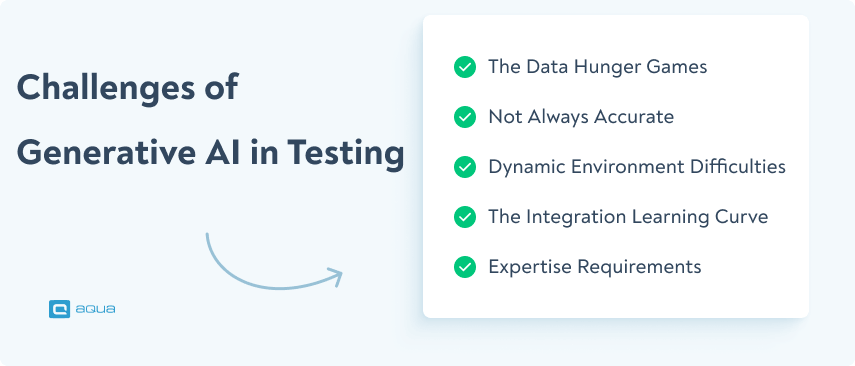In this post, we’ll dive into how generative AI is changing the game for software testing teams, the real benefits you’ll see, and how to start implementing it in your own QA strategy. We’ll provide the best practical insights on how this technology can help software testing and make your testing life easier.
From Manual Testing to Generative AI: How Fast Are We Moving?
The evolution of software testing is nothing short of extraordinary, considering how much and how fast it changed from humble beginnings to today’s AI-powered capabilities.
The Manual Era
Remember the days of clicking through applications with a test plan printout at your side? Manual testing was (and still is) the foundation of QA—methodical, thorough, but painfully slow and prone to human error. A single UI change could mean hours of re-testing.
Script-Based Automation Enters the Scene
Then came Selenium, QTP, and other automation frameworks—game changers that allowed us to record and replay tests. Great in theory, but in practice? Those brittle scripts broke with every minor UI update. We spent more time fixing test scripts than finding actual bugs.
Data-Driven and CI/CD Integration
As testing matured, we got smarter with test data and started hooking our tests into CI/CD pipelines. Testing became more continuous, but the fundamental challenge remained—creating and maintaining comprehensive test suites still required massive human effort.
The AI & ML Revolution
That brings us to today’s AI-powered testing tools, which represent a quantum leap forward. Rather than just automating manual processes, generative AI actually thinks about testing in new ways:
- Instead of executing predefined steps, it generates unique test cases based on understanding the application
- Rather than breaking when the UI changes, it adapts automatically
- Instead of testing what we tell it to, it explores edge cases we might never have considered
This shift from deterministic testing to intelligent, adaptive testing is as significant as the jump from manual to automated testing was—maybe even more so.
The Benefits and Challenges of Generative AI Software Testing
Let’s be real about what generative AI brings to the testing table— the benefits you can’t ignore and the potential headaches.
Benefits of Generative AI That Make Your Testing Life Better
Time Savings Through Automated Test Case Generation
With generative AI, you can create comprehensive test cases in seconds rather than hours. Just feed it your requirements, and watch as it generates titles, preconditions, steps, and expected results.
Now modern test management solutions offer test case creation features that take a few seconds instead of 20-30 minutes. A prime example of these solutions is aqua cloud.
With aqua, test case creation is no longer a bottleneck. Once your requirement is in the system, whether added manually or generated via voice or prompt, you can instantly generate test cases in any format, from traditional to BDD. Need different angles? aqua lets you generate multiple test cases from a single requirement using techniques like boundary value analysis, equivalence partitioning, or decision tables. That’s not all. aqua’s AI Copilot also generates realistic, synthetic test data in seconds, mapped directly to each test case. You can even turn complex scenarios from large epics or CSV requirement files into structured, executable test cases with a click. No manual formatting. No endless copying. Just clean, clear, coverage-ready tests—on demand.
Save up to 98% of time in the test planning and design stage
Better Test Coverage Without More Work
AI doesn’t get tired or take shortcuts. It methodically explores edge cases, negative scenarios, and boundary conditions that human testers might miss. The result? More thorough testing without expanding your team.
Using AI models like OpenAI Codex or GitHub Copilot can significantly streamline the process of generating software tests and code documentation. These tools can automatically suggest test cases and write documentation based on your code, saving time and reducing errors.
Reduced Test Maintenance Headaches
The “self-healing” capabilities of AI testing tools mean your tests can adapt to UI changes automatically. No more Monday mornings spent fixing broken tests because a button moved or a field name changed.
Challenges of Generative AI in Testing You Should Know About
The Data Hunger Games
Generative AI models need data—lots of it—to perform well. Without sufficient training data specific to your application, you might get generic or less effective results. As we discussed above, aqua cloud can generate test data in a second.
Not Always Accurate
AI isn’t perfect. It can sometimes generate test cases that are irrelevant, impossible to execute, or miss critical scenarios. You still need human oversight.
Dynamic Environment Difficulties
Applications with highly dynamic content or complex state management can challenge AI testing tools, which may struggle to handle continuously changing elements.
The Integration Learning Curve
Adding generative AI to your existing testing ecosystem requires thoughtful integration. There’s a learning curve for your team, and you’ll need to adapt processes to get the most from these new capabilities.
Expertise Requirements
Successfully implementing and managing generative AI testing often requires specialised knowledge that your team might need to develop or hire for.

Generative AI vs. Traditional Testing Methods
To understand why generative AI is such a big deal in testing, let’s compare it to traditional approaches:
| Aspect | Traditional Testing | Generative AI Testing |
|---|---|---|
| Test Creation | Manual creation based on requirements and experience | Automatic generation based on requirements, code analysis, and patterns |
| Adaptability | Brittle; tests break when the application changes | Adaptive, self-healing tests accommodate changes |
| Coverage | Limited to explicitly designed test cases | Creates diverse scenarios beyond what humans might envision |
| Maintenance | High maintenance overhead | Reduced maintenance through self-healing and adaptation |
| Resource Usage | A linear relationship between app complexity and testing effort | More efficient resource use through intelligent prioritisation |
The fundamental difference? Traditional testing is deterministic and bounded by human imagination, while generative AI testing is creative and exploratory. Traditional testing follows rules; generative AI discovers them.
Types of Generative AI Models
Different types of AI models power the testing revolution, each with unique strengths for specific testing challenges.
Generative Adversarial Networks (GANs)
GANs consist of two neural networks—a generator and a discriminator—working against each other to create increasingly realistic outputs. They’re especially valuable for:
- Creating synthetic test data that mirrors production data without privacy concerns
- Generating unusual but valid test scenarios that might not be considered in manual design
- Simulating user behaviour patterns for performance and load testing
For example, financial applications can use GANs to generate realistic transaction patterns without exposing actual customer data, making them ideal for security testing.
Transformer-Based Models
These models power many large language models (LLMs) and excel at understanding context and relationships. They’re perfect for:
- Analysing requirements documents and user stories to generate appropriate test cases
- Creating human-like test scripts based on understanding application functionality
- Processing both text and visual information for UI testing
If you’ve used ChatGPT to help write test cases, you’ve experienced a transformer model in action.
Variational Autoencoders (VAEs)
VAEs learn the underlying distribution of valid inputs for an application, making them useful for:
- Generating diverse test inputs that represent real-world usage
- Detecting anomalies that might indicate defects
- Testing complex systems with many possible states
Diffusion Models
While newer in testing applications, diffusion models excel at:
- Creating high-quality test data by gradually transforming random noise into coherent outputs
- Generating test cases for applications with visual components
- Producing subtle variations of existing test cases to improve coverage
The choice of model depends on your specific testing needs, but many modern testing platforms combine multiple model types to create comprehensive testing systems.
Generative AI in Software Testing: Key Techniques
Let’s explore the core techniques that make generative AI so powerful for testing.
Automated Test Case Generation
One of the most valuable applications is automatically generating test cases:
- Requirements-Based Generation: AI analyses user stories and specifications using natural language processing to create tests that verify all required functionality.
- Code Analysis-Based Generation: By examining application code, generative AI identifies potential edge cases and testing priorities.
Pattern-Based Generation: Learning from existing test suites, AI creates new test variations that explore additional paths.
I use Copilot. It’s really good if it has a couple of existing tests it can „copy“ from. It’s never 100% right but gives me enough boilerplate to be quicker than manually writing them.
This capability can produce complete test cases in seconds, including titles, preconditions, steps, and expected results.
Self-Healing Test Automation
Perhaps the biggest time-saver is self-healing test capability:
- Dynamic Element Identification: AI identifies UI elements even when properties change, reducing maintenance needs
- Automatic Script Updates: When application changes are detected, AI updates test scripts automatically
- Learning From Failures: Systems improve over time by learning from both successful and failed executions
This self-healing ability tackles one of testing’s biggest headaches: the constant maintenance of automated tests.
Test Data Generation
Creating realistic and diverse test data is another area where generative AI shines:
- Synthetic Data Creation: Generating data that mimics production characteristics without privacy concerns
- Edge Case Data: Creating unusual but valid data combinations that might trigger defects
- Domain-Specific Data: Tailoring generated data to specific application requirements
Good test data is essential for effective testing, and generative AI significantly enhances both quality and quantity while reducing the manual effort to create it.
aqua cloud, an all-around TMS goes beyond generating just test cases and test data in a few seconds, it also gives you full control of your testing suite. With 100% test coverage and visibility, you can link all your test cases back to their fitting requirements. Centralised repository keeps all your automated and manual tests together, no matter which approach you like more. Automation and project management integrations like Azure DevOps, Jira, Selenium, Jenkins, Ranorex, and many more enhances your test management and automation capabilities, while one-click bug-tracking native integration Capture is the cherry on top. Ready to step into fully AI-powered test management?
Go from spending hours on test creation to a few minutes
Practical Applications of Generative AI in Software Testing
Let’s look at how real QA teams are putting generative AI to work today.
Test Automation Acceleration
Organisations are using generative AI to dramatically speed up their test automation:
- Rapid Test Creation: Companies report generating test cases automatically and creating comprehensive test cases in seconds rather than hours or days
- Test Suite Optimisation: AI helps teams focus testing by pinpointing the impact of code changes and risks upfront
- Maintenance Reduction: Self-healing capabilities dramatically reduce the time spent fixing broken tests
Industry-Specific Applications
Different industries are applying generative AI to address their unique testing challenges:
- Healthcare: Testing teams ensure patient data privacy while thoroughly testing medical applications by generating synthetic patient data
- Finance: Organisations create complex test scenarios for applications that must handle regulatory requirements and edge cases in financial transactions
- Design and Creative: Companies with visual applications use generative AI to test AI models by producing diverse design inputs and validating visual outputs
Integration with CI/CD Pipelines
Generative AI is transforming how testing integrates with modern development practices:
- Automated Quality Gates: AI systems serve as intelligent quality gates in CI/CD pipelines
- Just-in-Time Testing: Running focused test suites that target only affected components
- Release Risk Assessment: Providing comprehensive risk analysis for potential releases
These applications show how generative AI is already delivering real value across industries and testing contexts.
Developing a QA Strategy with Generative AI
Ready to bring generative AI into your testing process? Here’s how to do it right.
Assessment and Planning
Start with a thorough evaluation of your current testing landscape:
- Identify Pain Points: What manual, repetitive testing tasks consume the most resources? Where do you have maintenance headaches or coverage gaps?
- Data Inventory: Assess what historical test data you have that could train AI models.
- Integration Requirements: How will AI tools fit with your existing testing frameworks and CI/CD pipelines?
- Success Metrics: Define clear, measurable objectives for your implementation.
Implementation Roadmap
Develop a phased approach to implementing generative AI:
- Start with Pilots: Begin with focused use cases where generative AI can show clear value with minimal disruption.
- Measure and Learn: Establish metrics to evaluate effectiveness in initial applications.
- Gradual Expansion: Based on early wins, methodically expand to additional testing areas.
- Continuous Refinement: Regularly assess and refine your approach based on feedback and outcomes.
Training and Upskilling QA Teams
Prepare your testing team to work effectively with AI:
- Technical Skills Development: Train on AI concepts and how to effectively use AI-powered testing tools.
- Role Evolution Support: Help testers understand how their roles will shift toward prompt engineering, result validation, and AI supervision.
- Collaborative Workflows: Establish processes that use the complementary strengths of humans and AI working together.
Data Strategy for AI Training
Develop a robust approach to collecting and managing training data:
- Data Augmentation: Implement methods to enhance both quantity and quality of training data.
- Real-World Data Integration: Incorporate data from actual user interactions to train models that understand real scenarios.
- Continuous Collection: Systematically gather new testing data to ensure models improve over time.
Governance and Ethical Considerations
Establish frameworks for the responsible use of AI in testing:
- Quality Assurance for AI: Validate AI-generated tests to ensure they meet standards before execution.
- Bias Monitoring: Regularly audit AI-generated test cases to prevent testing gaps due to biases.
- Human Oversight: Define clear roles for human supervision, especially for critical applications.
With this structured approach, you can maximise the value of generative AI while minimising potential challenges.
Future Trends in Generative AI for Software Testing
Where is generative AI in software testing headed? These emerging trends will shape the future.
Augmented Intelligent Testing
The future lies in deep collaboration between AI and human testers:
- AI will handle routine test case generation and execution with increasing autonomy
- Human testers will focus on complex scenarios and strategic quality planning
- Testing tools will be designed explicitly for this collaborative model
- Testing roles will evolve toward “AI supervision” rather than direct test creation
Industry-Specific Customizations
Testing tools are increasingly specialising to address industry-specific needs:
- Healthcare-focused tools incorporating regulatory compliance and patient safety
- Financial services testing, integrating security and compliance validation
- Gaming and media applications with specialised visual and performance testing
- Manufacturing and IoT testing addressing real-time systems
Enhanced Cloud-Based AI Testing
Cloud-based AI testing solutions continue to grow in capability:
- Offering elastic computing resources for AI model training
- Providing pre-trained models for different testing domains
- Enabling collaboration across distributed testing teams
- Facilitating continuous testing in CI/CD pipelines
Advanced Predictive Analytics
AI-driven prediction capabilities are becoming more sophisticated:
- Test impact analysis predicts precisely which tests need to be run
- Defect prediction identifies potential issues before code is committed
- Quality forecasting, estimating the impact of changes on overall application quality
- Risk assessment provides quantitative measures of release readiness
Deeper Integration with Development
Generative AI testing is becoming more integrated with development:
- AI-assisted test-driven development suggests tests during code creation
- Automated code reviews, including test coverage analysis (saves up to 80% of your time).
- Continuous feedback loops between development and testing
- Shift-left testing is enabled by AI’s ability to generate tests from early requirements
These trends point to a future where testing is more intelligent, more integrated with development, and more specialised to address specific industry needs.
Conclusion
Generative AI in software testing changes software testing from a largely manual or scripted process into an intelligent, adaptive system that continuously improves. Teams that embrace this technology effectively have a bigger chance of creating higher-quality software faster and gaining a significant competitive advantage.
The question isn’t whether generative AI will transform software testing—it already is. The real question is whether your team will be among those leading the charge or playing catch-up later.


















